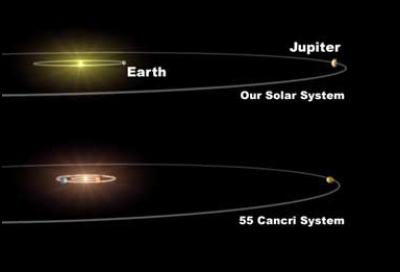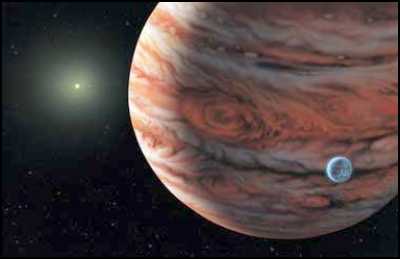Newfound Planetary System Has 'Hometown' Look
See: http://www.jpl.nasa.gov/releases/2002/release_2002_133.html

This graphic depiction compares our solar system with a newfound planetary system, 55 Cancri. The new system has a Jupiter-mass planet in an orbit similar to the orbit of our Jupiter. In addition, two other planets are shown orbiting 55 Cancri at distances closer than the distance between Earth and our Sun.

Credit: NASA/Lynette Cook
After 15 years of
observation and a lot of patience, the world's premier
planet-hunting team has finally found a planetary system
that reminds them of our own home solar system.
Dr. Geoffrey Marcy, astronomy professor at the University of California, Berkeley, and astronomer Dr. Paul Butler of the Carnegie Institution of Washington, Washington, D.C., today announced the discovery of a Jupiter-like planet orbiting a Sun-like star at nearly the same distance as the Jovian system orbits our Sun.
"All other extrasolar planets discovered up to now orbit closer to the parent star, and most of them have had elongated, eccentric orbits. This new planet orbits as far from its star as our own Jupiter orbits the Sun,'' said Marcy. NASA and the National Science Foundation fund the planet-hunting team.
The star, 55 Cancri in the constellation Cancer, was already known to have one planet, announced by Butler and Marcy in 1996. That planet is a gas giant slightly smaller than the mass of Jupiter and whips around the star in 14.6 days at a distance only one-tenth that from Earth to the Sun.
Using as a yardstick the 93-million mile Earth-Sun distance, called an astronomical unit or AU, the newfound planet orbits at 5.5 AU, comparable to Jupiter's distance from our Sun of 5.2 AU (about 824 million kilometers or 512 million miles). Its slightly elongated orbit takes it around the star in about 13 years, comparable to Jupiter's orbital period of 11.86 years. It is 3.5 to 5 times the mass of Jupiter.
"We haven't yet found an exact solar system analog, which would have a circular orbit and a mass closer to that of Jupiter. But this shows we are getting close, we are at the point of finding planets at distances greater than 4 AU from the host star," said Butler. "I think we will be finding more of them among the 1,200 stars we are now monitoring."
The team shared its data with Dr. Greg Laughlin, assistant professor of astronomy and astrophysics at the University of California, Santa Cruz. His dynamical calculations show that an Earth-sized planet could survive in a stable orbit between the two gas giants. For the foreseeable future, existence of any such planet around 55 Cancri will remain speculative.
"The existence of analogs to our solar system adds urgency to missions capable of detecting Earth-sized planets - first the Space Interferometry Mission and then the Terrestrial Planet Finder," said Dr. Charles Beichman, NASA's Origins Program chief scientist at the agency's Jet Propulsion Laboratory, Pasadena, Calif.
"This planetary system will be the best candidate for direct pictures when the Terrestrial Planet Finder is launched later this decade," said UC Berkeley astronomer Dr. Debra A. Fischer.
Marcy, Butler, Fischer and their team also announced a total of 13 new planets today, including the smallest ever detected: a planet circling the star HD49674 in the constellation Auriga at a distance of .05 AU, one-twentieth the distance from Earth to the Sun. Its mass is about 15 percent that of Jupiter and 40 times that of Earth. This brings the number of known planets outside our solar system to more than 90.
Discovery of a second planet orbiting 55 Cancri culminates 15 years of observations with the 3-meter (118-inch) telescope at Lick Observatory, owned and operated by the University of California. The team also includes Dr. Steve Vogt, University of California, Santa Cruz; Dr. Greg Henry, Tennessee State University, Nashville; and Dr. Dimitri Pourbaix, the Institut d'Astronomie et d'Astrophysique, Université Libre de Bruxelles.
The star 55 Cancri is 41 light years from Earth and is about 5-billion years old. Further data are needed to determine whether yet another planet is orbiting it, because the two known planets do not explain all the observed Doppler wobbling. One possible explanation is a Saturn-mass planet orbiting about .24 AU from the star.
JPL manages the Terrestrial Planet Finder and Space Interferometry Mission for NASA. JPL is a division of the California Institute of Technology in Pasadena. More information, including artist concept and animations, can be found on the Internet at:
http://www.jpl.nasa.gov/images/newplanets
http://exoplanets.org
http://planetquest.jpl.nasa.gov


 Takeovers Panel: Takeovers Panel Convenes Meeting To Inquire Into The Acquisition Of Shares In NZME Limited
Takeovers Panel: Takeovers Panel Convenes Meeting To Inquire Into The Acquisition Of Shares In NZME Limited WorkSafe NZ: Conveyor Belt Death-Trap Was A Danger In Plain Sight
WorkSafe NZ: Conveyor Belt Death-Trap Was A Danger In Plain Sight Commerce Commission: 2degrees Fined $325,000 For Misleading Claims About ‘Free’ Aussie Business Roaming
Commerce Commission: 2degrees Fined $325,000 For Misleading Claims About ‘Free’ Aussie Business Roaming  Natural Hazards Commission: Hub Launched To Empower Architects And Engineers To Build Above Code
Natural Hazards Commission: Hub Launched To Empower Architects And Engineers To Build Above Code Harmony Energy: Ceremony Heralds Start Of Construction On New Zealand’s Largest Solar Farm Project
Harmony Energy: Ceremony Heralds Start Of Construction On New Zealand’s Largest Solar Farm Project Stats NZ: Annual Number Of Home Consents Down 7.4 Percent
Stats NZ: Annual Number Of Home Consents Down 7.4 Percent



